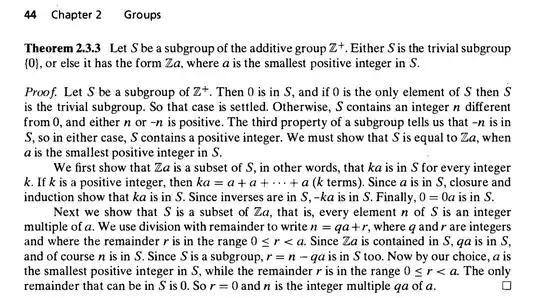I was able to follow most of the proof but I don’t understand how the author concludes that $r=0$ at the final part. I would appreciate it if someone could clarify. Thanks
-
1If $,r := n\bmod a\neq 0$ then it is a positive elt of $S$ smaller than $a$, contra minimality of $,a\ \ $ – Bill Dubuque Jan 07 '22 at 09:21
-
1We can also do the descent using subtraction (vs. mod = remainder), e.g. see here where it is used to derive the Bezout equation for the gcd - corresponding to the (extended) Euclidean algorithm (in subtractive or mod = remainder form). – Bill Dubuque Jan 07 '22 at 09:24
-
1The descent can be expressed more constructively as an algorithm to find a generator: choose a positive $,a_1\in S.,$ If $,a_1,$ divides all $,n\in S,$ then it generates $S$. Else some $,n\in S, $ is not divisible by $,a_1,$ so we obtain a smaller elt of $S$ via $,a_2 := n\bmod a_1.,$ Repeating, if $,a_2,$ doesn't generate then we find a smaller $,a_3\in S,, \ldots.,$ Since $\Bbb N,$ is well-ordered the sequence $,a_1 > a_2 > a_3 > \ldots > a_k> 0,$ must terminate with some $,a_k,$ that generates $,S.\ \ $ – Bill Dubuque Jan 07 '22 at 09:47
-
1We can also descend using $,a_{k+1} := \gcd(n,a_k)\ (= i n + j a_k,$ so is in $S).,$ Then the algorithm computes a generator by taking gcds of elts of $S$ till we get the gcd of all elts of $S$, which is clearly a generator (prove it!). – Bill Dubuque Jan 07 '22 at 09:52
-
1The method in the prior comment can be viewed as a generalization of the Euclidean algorithm from $\Bbb Z$ to any PID - see the Dedekind Hasse Criterion. The analogous result for PIDs is that each nonzero ideal is generated by any elt having least number of prime factors (the above descent by gcd yields a proper factor of $,a_k,$ so it has fewer prime factors). – Bill Dubuque Jan 07 '22 at 10:18
-
1Please don't rely on pictures of text. – Shaun Jan 07 '22 at 12:35
3 Answers
We know that $r = n-qa$ is an element of $S$ by the fact that $S$ is a group. If for a contradiction $r > 0$, then we know that $r$ will satisfy the compound inequality $0 < r < a$. However, this means that $r$ is an element of $S$ that is smaller than $a$, a contradiction to how we chose $a$ to begin with. Hence, it must be the case that $r = 0$.
- 2,609
If $r$ wasn't 0, it would be a positive integer, but the inequality $0\leq r < a$ tells us that it would be a positive integer smaller than $a$. However, since we chose $a$ to be the smallest positive integer in $S$ and $r\in S$, this yields a contradiction.
- 550
The proof states that $n=qa+r$, where $n\in S$ and $a$ is the smallest positive integer in $S$. Then $qa\in S$, since $S$ is a subgroup.
Then $r=n-qa$ lies also in $S$ as $S$ is a subgroup. But $r$ is the remainder of dividing $a$ into $n$ and so by def. $0\leq r <a$ But $a$ is smallest with the properties $a>0$ and $s\in S$. This forces $r$ to be $0$.
- 20,964
